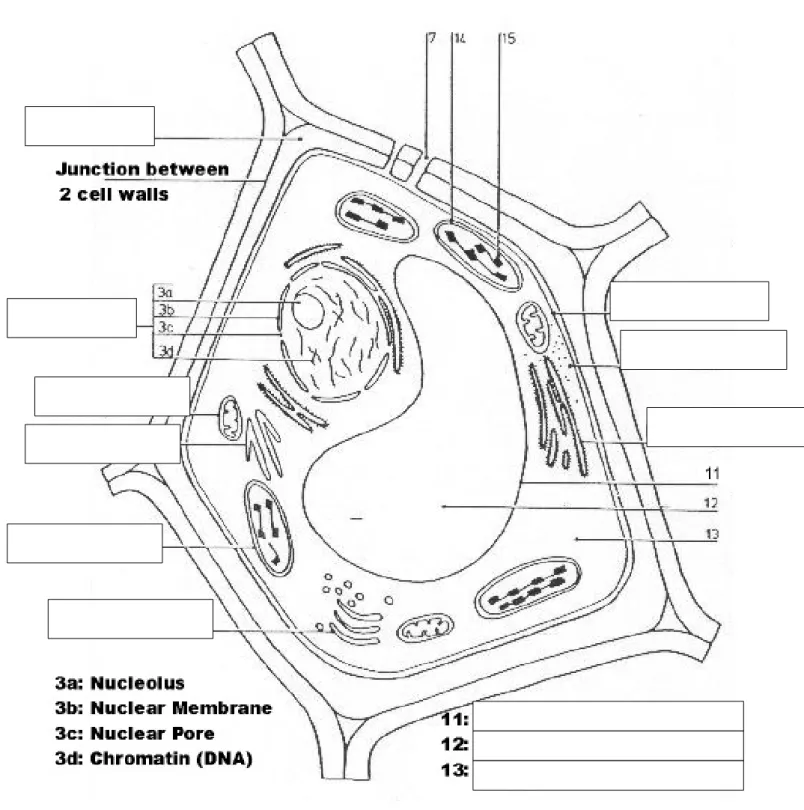THE STRUCTURE OF A TYPICAL PLANT AND ANIMAL CELL
Plants and animals are made up of small units called ___________. These units can be thought of as bricks which are used to
build houses.
Although the bricks are similar, they can be joined together in a number of ways to create different shapes and sizes.
• In much the same way, these tiny cells make up organisms like plants and animals that
vary greatly in shape and size.
• Cells also vary greatly in shape and structure, and plant cells do not look the same as animal cells,
THE STRUCTURE OF A PLANT CELL A. THE CELL WALL
Structure:
• Plant cells are surrounded by a non-living cell wall.
• In most plants the cell walls are made of cellulose which is a carbohydrate that cannot be digested by most animals.
• In our diet it is essential as roughage and promotes the movement of food
through the digestive system.
• Minute openings called pits occur in the cell wall. The pits allow communication
between the cells next to each other.
• The cell wall is permeable.
Find out the meaning of this word.
_____________________________________________________________ _____________________________________________________________
Function:
• The cell wall is a rigid structure which gives the cell its shape, strengthens it and protects the contents.
B. THE CELL MEMBRANE (PLASMA MEMBRANE) Structure:
• This is found just inside the cell wall.
Function
• The cell membrane is able to control the exit and entry of substances out of and
into the cell.
• The cell membrane is said to be semi-permeable or selectively permeable. This
means that:____________________________________________________ _____________________________________________________________
C. THE PROTOPLASM
• This refers to the cell contents.
• The protoplasm consists of two parts: the cytoplasm and the nucleus.
1. THE CYTOPLASM:
• Cytoplasm is a jelly-like, colourless substance.
• Structures found inside the cytoplasm are called organelles.
• Each organelle has a particular function and therefore a particular structure.
• The cytoplasm has a grey appearance, because of the organelles it contains.
ORGANELLES
i. Mitochondria (plural)
• A mitochondrion (single) is an organelle that plays an important part in getting
energy from the food produced by the plant.
• The process by which energy is liberated is referred to as cellular respiration. • During cellular respiration, oxygen and glucose go through a chemical reaction
to produce energy, carbon dioxide and water.
• Mitochondria also store the energy set free during this process.
• For this reason the mitochondrion is often called the powerhouse of the cell.
ii. Vacuole:
• The vacuole is a fluid filled space in a plant cell and is surrounded by a
membrane called the tonoplast.
• The fluid in the vacuole is called cell sap.
• Cell sap consists of water and dissolved substances such as mineral salts, organic food substances and waste products.
• Immature plant cells often contain more than one smaller vacuole.
• In older plant cells one large vacuole usually occupies most of the volume of the
cell.
iii. Plastids:
• Only appear in plant cells.
• There are three types of plastids:
a. Chloroplasts:
• Chloroplasts are oval bodies which contain a green pigment called chlorophyll.
• Chlorophyll traps the suns radiant energy and uses it to produce glucose.
• Glucose is the plants food.
• Plants can change glucose into starch which is then stored by the plants for later use.
• The process used by plants to make food/glucose is called Photosynthesis.
Radiant energy
Carbon dioxide + water glucose +
oxygen
b. Leucoplasts:
• These are colourless or white plastids.
• The function of the leucoplast is to store food, e.g. in the potato tuber they store starch.
c. Chromoplasts:
• Chromoplasts are plastids which produce colour.
• They are responsible for the orange / yellow / red colour in tomatoes, carrots,
some fruit, autumn leaves and the petals of many flowers.
iv. Endoplasmic reticulum
Endoplasmic reticulum (ER) are tubes of membranes that run throughout the cell.
ER creates channels through which substances can move.
ER is also responsible for making substances in the cell
Rough endoplasmic reticulum (RER)
RER has ribosomes which are little protein factories all along its surface, this gives RER its rough appearance.
RER’s function is to make and transport proteins.
Smooth endoplasmic reticulum (SER)
SER is smooth in appearance.
v. Golgi apparatus
Golgi apparatus package secretions for transport within and out of the cell.
It consists of several joined sac membranes. Secretions bud of in little sacs called vesicles from the Golgi apparatus.
2. The nucleus
• The nucleus, together with the cytoplasm forms the protoplasm of the cell.
• The nucleus is surrounded by a nuclear membrane. The nuclear membrane has small
holes in it called nuclear pores that allow information to leave the nucleus.
• Inside the nuclear membrane is the liquid of the nucleus, referred to as
nucleoplasm.
• The nucleus can clearly be seen in a cell because the nucleoplasm contains the chromatin network, which gives it a denser appearance than the cytoplasm.
• The chromatin network contains the all-important genes that transfer characteristics such as eye colour, hair colour and other family traits.
• The nucleus controls all the activities of the cell.
• In many cells the nucleus contains one or more small oval bodies called nucleoli
(singular nucleolus).
• Practical’s: Micrographs
Slide of plant cell- onion membrane Slide of animal cells- cheek cells
Table 1: The differences between plants and animal cells
Feature Plant cell Animal cell
Cell wall
Shape
Vacuoles


